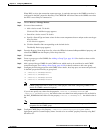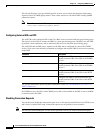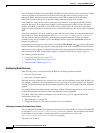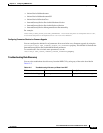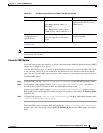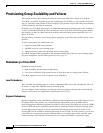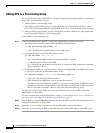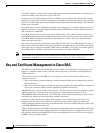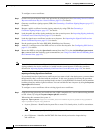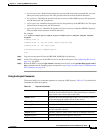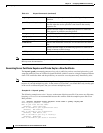
12-17
Cisco Broadband Access Center 3.8 Administrator Guide
OL-27172-01
Chapter 12 Configuring CWMP Service
Provisioning Group Scalability and Failover
Typically, you can configure regional redundancy by using DNS techniques. To configure the network
for regional redundancy, ensure that the Cisco BAC hostname of a given provisioning name normally
resolves to IP address(es) representing one set of DPEs.
However, when none of the DPE servers in that set responds to keepalives, such as ICMP, HTTP GET,
or a TCP handshake, the DNS server should resolve the Cisco BAC hostname to the IP address(es) of
the DPEs from a second set. CPE requests are then directed to a different set of DPEs.
Since DPEs in both sets belong to the same provisioning group, the new DPEs are ready to respond to
requests. Subsequent DNS lookup requests fall back to the primary set of DPEs as soon as they become
available.
DPE Load-Balancing
Cisco BAC supports the following mechanisms for DPE redundancy and load-balancing:
• Using DNS Round Robin, page 12-17
• Using a Hardware Load Balancer, page 12-17
Using DNS Round Robin
In using the DNS round-robin mechanism, the DNS server shuffles the list of DPE IPs when resolving
the autoconfiguration server (ACS) hostname for the device. The device then takes the first IP address
in the list as the ACS hostname.
This option is not recommended if the service provider does not control DNS caching servers. Also, DNS
round-robinning performs less than ideally in a power outage scenario, when a large number of devices
may receive the same order IP address cached by the DNS server, thus impacting performance. To work
around this issue, Cisco recommends configuring a very short TTL of 1 second on the DNS server.
Using a Hardware Load Balancer
When a hardware load balancer is used, the ACS URL contains the IP address or is resolved by the DNS
server to a single IP address. All DPEs for a provisioning group are hidden behind a single virtual IP
address of the hardware load balancer, such as Cisco ACE 4710.
The ACE provides load balancing and SSL/TLS acceleration for TR-069 traffic between the CWMP
devices and the DPEs. You can configure the ACE to translate its virtual IP address to a specific DPE IP
address, based on a load-balancing algorithm. ACE performs a series of checks and calculations to
determine the DPE that can best service each device request according to the load-balancing algorithm.
ACE also provides stickiness that allows the same device to maintain multiple simultaneous or
subsequent connections with the same DPE for the duration of a session.
A redundant pair of load balancers can improve redundancy and may service more than one provisioning
group.



